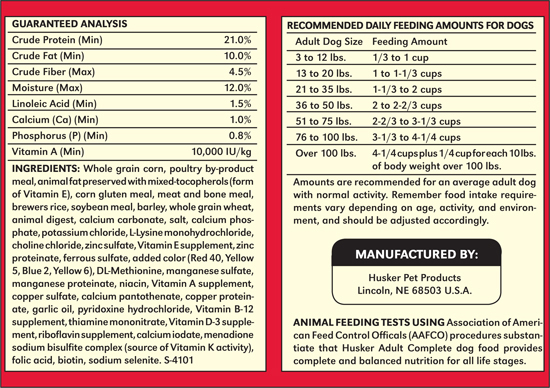When you are at the grocery store buying food for your family for the week, you look at the nutrition labels to determine if the item is high in calories, sodium, fat, etc. You also look at the ingredients to make sure they are good for you. Do you do the same when looking for food and treats for your pets? Pets need good quality food too. Eating a healthy, natural diet will extend the life of your pets and they will be happier too. Their coat and skin will be softer, breath will be fresher, shedding will decrease and more! Imagine if you ate Fast Food every day for every meal for years, you wouldn’t be feeling to healthy either…and you would probably be overweight and out of shape too. Think of the lower quality pet food as their fast food.
According to the FDA Website….
“The Federal Food, Drug, and Cosmetic Act (FFDCA) requires that all animal foods, like human foods, be safe to eat, produced under sanitary conditions, contain no harmful substances, and be truthfully labeled. However, there is no requirement that pet foods have pre-market approval by FDA. Many ingredients such as meat, poultry and grains are considered safe and do not require pre-market approval. Other substances such as sources of minerals, vitamins or other nutrients, flavorings, preservatives, or processing aids may be generally recognized as safe (GRAS) for an intended use or must have approval as food additives. Colorings must have approvals for that use. ”
So what does that mean…. That means that if a manufacturer uses meat, poultry and grains, they do not need to get approval before they use it. They can use all parts of the animal, even those that are not suitable for human consumption. As for the vitamins, minerals, nutrients, flavorings, preservatives, and processing aids, they are typically classified as “generally recognized as safe” so also do not need FDA approval. So basically the ingredients in your pet’s food may not contain the better ingredients or may contain so many additives and processing aids, that the nutritional value is very low.
For more information on the the regulation of pet food, the labels, and the marketing of pet food, please visit the FSA site links below.
- Pet Food: The Lowdown on Labels
- Pet Food Labels – General
- Information on Marketing a Pet Food Product
Quick Tutorial on Pet Food Labels

Key Tips to look for on Food Labels
- The first ingredient listed should always be a protein. For Example: Chicken, Beef, Salmon, Veal, Lamb, etc. The listing of ingredients on pet food labels are by weight, not volume like in people food. If the first ingredient is a grain or starch like rice or corn, then there has to be an awful lot in the food for it to be heavier than the protein…especially if the protein is beef or chicken.
- It must not contain any “By-Products” which are that have not been heat processed. They may contain heads, feet, viscera and other animal parts.
- It also must not contain any “Meal” which is the processing or heating of the ingredient to remove the fat and water. Meal is not the best but you can get away with food that has chicken meal, beef meal, or any other type that you know the protein. But if the ingredients include “Bone Meal”, “Poultry Meal”, “Fish Meal”, etc, that is not desirable for you don’t know what kinds of poultry, fish, bone, etc are used or what parts were actually used. It could include the bones, beaks, hooves, organs, etc.
- You should be able to understand and identify all the ingredients leading up to the “animal fat (preserved with…”, typically the first 5 – 7 ingredients.
Many lower grade foods include chemical preservatives, synthetic vitamins and minerals, additives, fillers and supplements. These ingredients can react with your pet’s digestion and cause your pet to have loose stool, gas, bad breath, itchiness and allergies, increased shedding, and more. The lower the quality of the food, the higher the chance your pet is reacting to it.
If you would like to learn more about how to read your pet’s food label and how to provide the best nutritional food for them, please check out our Services page for information on scheduling an individual or group educational seminar.
As always, if you have any questions, or need any help picking the best food for your pet, please feel free to contact me.





